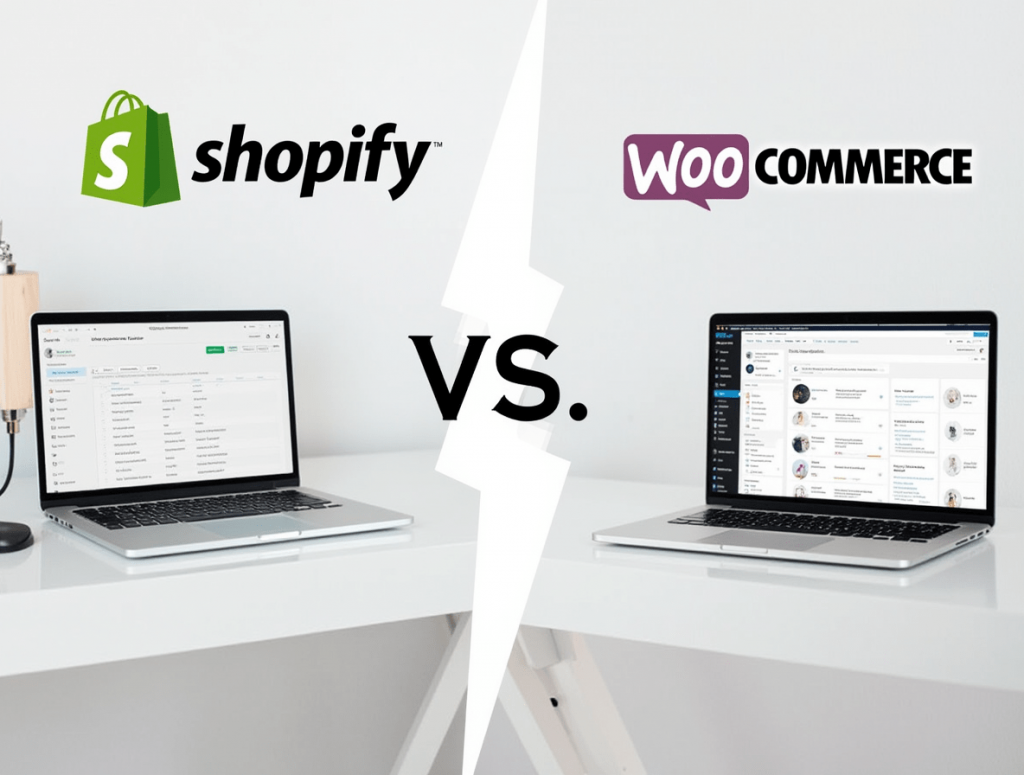
Did you know that global e-commerce sales are projected to reach $7.4 trillion by the end of 2025? Yet despite this massive market opportunity, studies show that 90% of e-commerce startups fail within their first 120 days—often due to choosing the wrong platform for their specific business needs.
For entrepreneurs and established businesses alike, the decision between Shopify and WooCommerce represents more than just selecting a tool—it’s a strategic choice that impacts everything from daily operations to long-term scalability. Each platform offers distinct advantages and limitations that can significantly influence your online store’s success trajectory.
In this comprehensive comparison, we’ll examine how these leading e-commerce solutions stack up across critical factors including ease of use, cost structure, customization capabilities, and performance. By the end, you’ll have a clear understanding of which platform aligns best with your unique business requirements, technical capabilities, and growth ambitions.
Understanding the Fundamentals
What Is Shopify?
Shopify is a complete, hosted e-commerce platform that provides everything needed to create and manage an online store. Founded in 2006, it has grown to power over 4 million active stores globally. As a Software-as-a-Service (SaaS) solution, Shopify handles the technical aspects of running an e-commerce website, including hosting, security, and core functionality.
The platform operates on a monthly subscription model with tiered pricing plans, making it accessible to businesses of various sizes—from solo entrepreneurs to enterprise-level operations. Its all-in-one approach emphasizes simplicity and reliability, with 24/7 support included in all plans.
What Is WooCommerce?
WooCommerce is an open-source e-commerce plugin built for WordPress, the world’s most popular content management system. Launched in 2011 and later acquired by Automattic (WordPress’s parent company), WooCommerce now powers approximately 29% of all online stores.
Unlike Shopify, WooCommerce is not a standalone platform but rather an extension that transforms a WordPress website into a fully functional e-commerce store. This integration with WordPress gives store owners exceptional content management capabilities alongside their e-commerce functionality.
The plugin itself is free, but users must arrange their own hosting, domain, security, and potentially additional extensions—creating a more à la carte pricing structure with both advantages and challenges.
Setup and Ease of Use
Getting Started with Shopify
Shopify is designed for simplicity from the outset:
- Time to Launch: A basic store can be operational within hours
- Technical Requirements: Minimal—no coding knowledge necessary
- Guided Setup: Step-by-step wizards and onboarding processes
- Domain Options: Purchase through Shopify or connect existing domain
- SSL Certificate: Included automatically with all plans
- Initial Configuration: Pre-configured payment processing, tax settings, and shipping options
For non-technical entrepreneurs, Shopify’s streamlined setup process represents a significant advantage. The platform handles complex e-commerce infrastructure invisibly, allowing owners to focus on products and marketing rather than technical implementation.
Getting Started with WooCommerce
WooCommerce setup involves more steps and decisions:
- Prerequisites: Requires existing WordPress installation on a hosting service
- Installation Process: Plugin installation plus configuration of multiple settings
- Technical Knowledge: Basic WordPress familiarity helpful; some technical comfort advantageous
- Domain & Hosting: Must be purchased and configured separately
- SSL Certificate: Generally available through hosting provider, often at additional cost
- Initial Configuration: Manual setup of payment gateways, tax rules, and shipping options
While potentially more complex initially, this process provides greater foundational knowledge of your store’s architecture and operation. For businesses with existing WordPress sites or technical resources, this additional control may outweigh the steeper learning curve.
Design and Customization
Shopify’s Theme Ecosystem
Shopify’s approach to design centers on professional, ready-to-use themes:
- Theme Store: Over 100 premium themes ($180-$350) and 9 free options
- Customization Tools: User-friendly theme editor with section-based customization
- Mobile Responsiveness: All official themes fully optimized for mobile shopping
- Design Quality: Professionally designed templates with regular updates
- Code Access: Limited access to HTML/CSS for customization
- Developer Options: Specialized Liquid templating language for advanced customization
For most merchants, Shopify themes provide sufficient flexibility without requiring design expertise. The controlled environment ensures compatibility and performance while sacrificing some level of creative freedom.
WooCommerce’s Design Flexibility
WooCommerce inherits WordPress’s exceptional design flexibility:
- Theme Options: Thousands of compatible WordPress themes plus WooCommerce-specific themes
- Customization Depth: Complete access to all code aspects (PHP, HTML, CSS, JavaScript)
- Page Builders: Compatible with visual editors like Elementor and Divi
- Template Hierarchy: Sophisticated system for targeted customization of specific elements
- Child Themes: Structured approach to customization that preserves update compatibility
- Developer Freedom: Unlimited potential for unique implementations
This extensive control comes with greater responsibility—while WooCommerce can achieve virtually any design vision, implementing complex customizations requires correspondingly advanced skills or professional assistance.
Core Features Comparison
Product Management
Shopify:
- Intuitive product creation interface
- Built-in support for physical products, digital downloads, and services
- Unlimited products on all paid plans
- Robust inventory management system
- Bulk import/export capabilities
- Simple variant management (up to 100 combinations per product)
- Integrated product reviews (or through apps)
WooCommerce:
- WordPress-integrated product management
- Support for all product types with appropriate extensions
- Unlimited products and categories
- Basic inventory features with extension options
- CSV import/export functionality
- Flexible product attributes and variations system
- Multiple product review options
Both platforms handle standard product management effectively, but differences emerge with complex requirements. Shopify offers a more streamlined experience out-of-the-box, while WooCommerce provides deeper customization potential when extended.
Payment Processing
Shopify:
- Shopify Payments (powered by Stripe) with preferential rates
- Additional transaction fees (0.5%-2%) when using external payment gateways
- Over 100 payment gateway integrations
- Shop Pay accelerated checkout option
- Built-in fraud analysis tools
- Automatic tax calculation in most jurisdictions
- Multicurrency selling available on higher plans
WooCommerce:
- No native payment processing (requires gateways)
- No additional transaction fees beyond gateway charges
- WooCommerce Payments (also Stripe-powered) available
- Dozens of payment gateway extensions
- Flexible checkout customization
- Tax calculation through extensions
- Multicurrency capabilities via plugins
Shopify’s integrated payment ecosystem offers convenience but potentially higher costs, especially when using third-party gateways. WooCommerce provides more payment flexibility without platform fees, though implementation requires more effort.
Sales Tools and Marketing
Shopify:
- Abandoned cart recovery (except on basic plan)
- Built-in blog functionality
- Discount codes and gift cards
- Social media selling integrations
- Product review systems
- SEO tools and customizable metadata
- Email marketing through Shopify Email
- Point of sale integration for omnichannel selling
WooCommerce:
- WordPress’s powerful native blogging system
- Coupon and discount management
- Extensions for abandoned cart functionality
- Full access to WordPress’s SEO capabilities
- Product reviews through WordPress comments system
- Integrations with major marketing platforms
- Compatible with various email marketing solutions
- Point of sale extensions available
WooCommerce benefits immensely from WordPress’s content management strengths, making it particularly strong for content marketing and SEO. Shopify offers more integrated sales tools but may require apps for advanced marketing functionality.
App Ecosystems and Extensibility
Shopify App Store
Shopify’s extension marketplace features:
- Over 8,000 apps (both free and paid)
- Strict review process for quality control
- Consistent user experience across apps
- Simplified one-click installation
- Centralized billing for paid apps
- Apps for virtually every e-commerce function
- First-party apps for core business needs
The Shopify App Store represents a strength and potential weakness—while providing solutions for almost any requirement, complex stores may require multiple paid apps, significantly increasing monthly operating costs.
WooCommerce Extensions
WooCommerce’s extension ecosystem offers:
- 500+ official extensions plus thousands of third-party options
- WordPress plugin compatibility (50,000+ potential integrations)
- Typically one-time purchases rather than subscriptions
- Variable quality control, especially for third-party extensions
- Manual installation and configuration
- Greater potential for conflicts between extensions
- Deep integration possibilities with WordPress ecosystem
WooCommerce’s open architecture provides exceptional flexibility but requires more careful planning and management. The one-time purchase model for many extensions can be cost-effective for long-term operations.
Pricing Structures
Shopify’s Subscription Model
Shopify’s transparent pricing includes:
Basic Shopify ($29/month):
- Essential e-commerce functionality
- 2 staff accounts
- 2.9% + 30¢ transaction fee (with Shopify Payments)
- Limited reporting capabilities
- 2% fee for external payment processors
Shopify ($79/month):
- 5 staff accounts
- Enhanced reporting
- 2.6% + 30¢ transaction fee
- 1% fee for external payment processors
- Professional reports
- Abandoned cart recovery
Advanced Shopify ($299/month):
- 15 staff accounts
- Advanced reporting and analytics
- 2.4% + 30¢ transaction fee
- 0.5% fee for external payment processors
- Third-party calculated shipping rates
- Custom report builder
Additional Costs:
- Premium themes ($180-$350 one-time)
- Apps ($0-$200+/month depending on needs)
- Transaction fees (variable by payment method)
- Point of Sale hardware (if applicable)
WooCommerce’s Cost Components
WooCommerce costs are more distributed:
Core Components:
- WordPress hosting ($5-$300+/month depending on size and traffic)
- Domain name ($10-$20/year)
- SSL certificate ($0-$200/year depending on provider)
- WooCommerce plugin (free)
Common Additional Expenses:
- Premium theme ($0-$200 one-time)
- Extension costs ($0-$299 per extension, typically one-time)
- Developer assistance (highly variable)
- Payment gateway fees (similar to Shopify)
- Security services ($50-$200/year)
- Performance optimization ($0-$200/year)
For small to medium stores, WooCommerce often proves more economical in the long run due to one-time purchases versus ongoing subscriptions. However, initial setup costs and technical requirements may be higher.
Performance and Scalability
Shopify’s Managed Infrastructure
Shopify handles technical performance aspects:
- Unlimited bandwidth on all plans
- Global CDN included
- Automatic platform updates
- Guaranteed uptime (99.98% average)
- Built-in performance optimization
- Seamless scaling for traffic spikes
- Enterprise-grade security infrastructure
- Regular backup systems
This managed approach eliminates technical concerns but offers limited control over server configuration or optimization techniques.
WooCommerce’s Self-Managed Approach
WooCommerce performance depends largely on implementation:
- Host-dependent server quality and configuration
- Manual or host-provided CDN implementation
- Responsibility for WordPress and plugin updates
- Performance optimization requires expertise
- Caching configuration needed for scale
- Database optimization for large catalogs
- Security implementation falls to store owner
- Backup systems must be established separately
With appropriate expertise and investment, WooCommerce can achieve exceptional performance at scale. However, this requires significantly more technical management than Shopify’s turnkey solution.
SEO Capabilities
Shopify’s SEO Framework
Shopify provides structured SEO tools:
- Customizable title tags and meta descriptions
- Automatically generated sitemaps
- Canonical tags for product variants
- Customizable URL structures (with limitations)
- Clean navigation hierarchies
- Mobile optimization (Google-friendly)
- Reasonable page speed performance
- Blog functionality for content marketing
While covering essential SEO bases effectively, Shopify imposes certain limitations, such as URL structure constraints and inability to modify server configurations for advanced optimizations.
WooCommerce’s SEO Potential
WooCommerce benefits from WordPress’s SEO heritage:
- Complete control over all SEO elements
- Premium SEO plugins like Yoast SEO and Rank Math
- Custom permalink structures
- Advanced schema markup options
- Full content management system for SEO content
- Server-level optimization possibilities
- Unlimited customization of metadata
- Robust internal linking capabilities
For SEO-focused businesses, WooCommerce’s flexibility provides significant advantages, particularly for content-driven SEO strategies and technical optimization.
Security Considerations
Shopify’s Security Model
As a hosted platform, Shopify manages security comprehensively:
- Level 1 PCI DSS compliance included
- Automatic security updates
- DDoS protection
- Secure payment processing
- Regular security audits
- Fraud analysis tools
- SSL certificates provided
- Customer data protection systems
This approach virtually eliminates security concerns for merchants, representing a major advantage for businesses without technical security expertise.
WooCommerce’s Security Requirements
WooCommerce security responsibilities fall largely to the store owner:
- Host-dependent security measures
- Manual WordPress and plugin updates
- PCI compliance requirements depends on payment setup
- Security plugin implementation recommended
- SSL certificate management
- Regular backup procedures
- Vulnerability scanning needs
- Potential for security breaches if improperly maintained
While WordPress and WooCommerce can be highly secure when properly configured and maintained, this requires vigilance and technical knowledge that not all merchants possess.
Integration Capabilities
Shopify’s Integration Approach
Shopify focuses on streamlined integrations:
- ERP connections through apps or API
- Inventory management system connections
- Marketing platform integrations
- Shipping and fulfillment partnerships
- CRM system connections
- Accounting software compatibility
- Marketplace channel integrations (Amazon, eBay, etc.)
- Social media selling features
The platform’s structured API and app ecosystem makes integrations straightforward but sometimes less flexible than open-source alternatives.
WooCommerce’s Integration Flexibility
WooCommerce offers exceptional integration potential:
- Direct database access for custom integrations
- REST API for programmatic connections
- Thousands of pre-built integrations via WordPress
- Custom integration development potential
- Webhook capabilities for real-time data exchange
- Third-party integration platforms compatibility
- Legacy system connection possibilities
- Middleware compatibility
This flexibility makes WooCommerce particularly suitable for businesses with complex existing systems or unique integration requirements.
Support and Community
Shopify’s Professional Support
Shopify offers comprehensive official support:
- 24/7 live chat, email, and phone support
- Extensive documentation and tutorials
- Active community forums
- Solution partner network for implementation
- Shopify Experts marketplace
- Regular webinars and training
- Annual Shopify Unite conference
- Structured onboarding assistance
This professional support ecosystem provides reassurance for businesses without in-house technical resources.
WooCommerce’s Community Support
WooCommerce relies more heavily on community resources:
- Limited official support for core products
- Extensive WordPress community knowledge
- Third-party developers and agencies
- Online documentation and knowledge base
- WooCommerce specific forums
- WordPress Meetups and WordCamps
- Stack Exchange and other developer communities
- YouTube tutorials and online courses
While rich in resources, this distributed support model may prove challenging for users requiring immediate assistance without established connections in the WordPress ecosystem.
Business Model Implications
Shopify’s Ecosystem Control
Shopify’s closed ecosystem has business implications:
- Platform lock-in concerns
- Controlled feature development
- Transaction fee leverage toward Shopify Payments
- Consistent but limited customization
- Predictable monthly costs
- Reduced technical hiring requirements
- Focus on commerce over content
- Limited data ownership and portability
This model favors businesses seeking reliability and simplicity over maximum control and ownership.
WooCommerce’s Open Ownership
WooCommerce’s open-source nature affects business strategy:
- Complete ownership of platform and data
- Freedom from platform dependency
- Unlimited business model flexibility
- Greater initial investment in setup
- Potentially lower long-term costs
- Technical resource requirements
- Content and commerce integration
- Responsibility for all aspects of operation
This approach resonates with businesses prioritizing independence and long-term control over immediate convenience.
Which Platform Is Right for Your Business?
Ideal Scenarios for Shopify
Shopify typically works best for:
- New entrepreneurs with limited technical experience
- Businesses prioritizing rapid launch over perfect customization
- Retail-focused operations with straightforward product catalogs
- Companies with limited technical resources seeking reliability
- Brands requiring excellent mobile experiences out-of-the-box
- Multi-channel sellers needing unified inventory across marketplaces
- Businesses comfortable with stable monthly expenses
- Stores requiring predictable scaling without technical overhead
Ideal Scenarios for WooCommerce
WooCommerce generally excels for:
- Technically comfortable entrepreneurs or those with developer access
- Content-heavy business models leveraging WordPress’s CMS capabilities
- Custom product scenarios requiring unique shopping experiences
- Businesses with specific design requirements beyond template capabilities
- International sellers needing complete localization control
- Budget-conscious operations seeking to minimize recurring costs
- Stores with complex integration requirements to existing systems
- Businesses placing high value on platform ownership and control
Migration Considerations
For businesses considering switching platforms, several factors deserve attention:
Migrating from Shopify to WooCommerce
- Data export challenges: Product information, customer data, and order history require careful migration
- URL structure changes: SEO implications from changed permalinks
- Payment processing transitions: Need to establish new payment gateway relationships
- Design recreation: Shopify themes don’t transfer to WordPress
- App functionality replacement: Finding WordPress equivalents for Shopify apps
- Technical skill requirements: Significantly increased compared to Shopify
Migrating from WooCommerce to Shopify
- Design limitations: Potentially less customization than original WordPress setup
- Extension replacement costs: Shopify apps often use subscription models vs. one-time WooCommerce purchases
- Content migration challenges: WordPress content doesn’t always map cleanly to Shopify’s blog
- Custom function loss: Specialized WordPress functionality may not be replicated
- Monthly cost increase: Typically higher recurring expenses
- Reduced technical complexity: Generally simplified management
Migration tools exist for both directions but rarely provide completely seamless transitions, making platform choice particularly important for established businesses.
Future Outlook and Trends
Shopify’s Evolution
Shopify continues developing in several directions:
- Expansion of Shopify Fulfillment Network
- Enhanced enterprise capabilities through Shopify Plus
- Increased headless commerce options with StorefrontAPI
- Greater focus on international markets and localization
- Integration of augmented reality shopping experiences
- Improved point-of-sale offerings for omnichannel retail
- Development of Shop app as consumer-facing platform
- Artificial intelligence applications for merchandising
WooCommerce’s Trajectory
WooCommerce development focuses on:
- Enhanced WordPress editor (Gutenberg) integration
- Improved mobile management capabilities
- Expansion of WooCommerce Payments availability
- Performance optimization for large catalogs
- Advanced multichannel selling capabilities
- Progressive web app features
- Improved analytics and reporting
- Simplified store management experience
Both platforms continue evolving to address their respective weaknesses while maintaining their core differentiation in the market.
Conclusion: Making Your Decision
The choice between Shopify and WooCommerce ultimately depends on your specific business requirements, technical capabilities, and long-term objectives.
Shopify delivers exceptional value for businesses seeking a hassle-free e-commerce solution with professional support and integrated features. Its structured environment and predictable costs provide peace of mind, particularly for entrepreneurs without technical backgrounds or those prioritizing operational simplicity.
WooCommerce offers unparalleled flexibility and ownership at the cost of greater technical responsibility. For content-focused businesses, those with specific customization needs, or companies concerned about platform dependency, WooCommerce’s open architecture and integration with WordPress create compelling advantages.
Rather than viewing either platform as inherently superior, consider which better aligns with your business model, available resources, and growth trajectory. Many successful e-commerce operations begin on the more accessible Shopify platform before transitioning to WooCommerce as their requirements grow more specialized—while others find that Shopify’s enterprise offerings eliminate any need to change platforms.
Whatever your decision, both platforms provide proven paths to e-commerce success when implemented with clear strategic objectives and appropriate expectations.
Frequently Asked Questions
Is WooCommerce really free compared to Shopify?
While WooCommerce itself is free, the total cost of ownership includes hosting, security, extensions, and potentially technical assistance. For simple stores, WooCommerce often proves more economical long-term, but complex implementations may equal or exceed Shopify’s predictable subscription costs.
Which platform is better for SEO?
WooCommerce typically offers more comprehensive SEO capabilities due to WordPress’s content management strengths and flexible customization options. However, Shopify covers essential SEO needs effectively and may perform better out-of-the-box without optimization.
Can I switch platforms later if my business needs change?
Yes, migration between platforms is possible, though it requires careful planning and may involve some data or functionality compromises. The difficulty increases proportionally with store size, customization complexity, and sales volume.
Which platform handles high-traffic volumes better?
Properly configured, both platforms can handle significant traffic. Shopify manages scaling automatically at no additional cost, while WooCommerce requires appropriate hosting infrastructure and optimization, offering potentially higher performance ceiling but with greater technical requirements.
Do I need a developer for either platform?
Shopify can be implemented without development assistance for standard stores using available themes and apps. WooCommerce typically benefits from at least initial technical setup help unless the store owner has WordPress experience. Complex customizations on either platform generally require professional development support.
Which platform offers better mobile experiences?
Both platforms can deliver excellent mobile experiences. Shopify’s themes are consistently mobile-optimized out of the box, while WooCommerce’s mobile experience depends on theme choice and implementation quality. Either can achieve optimal mobile performance when properly configured.














